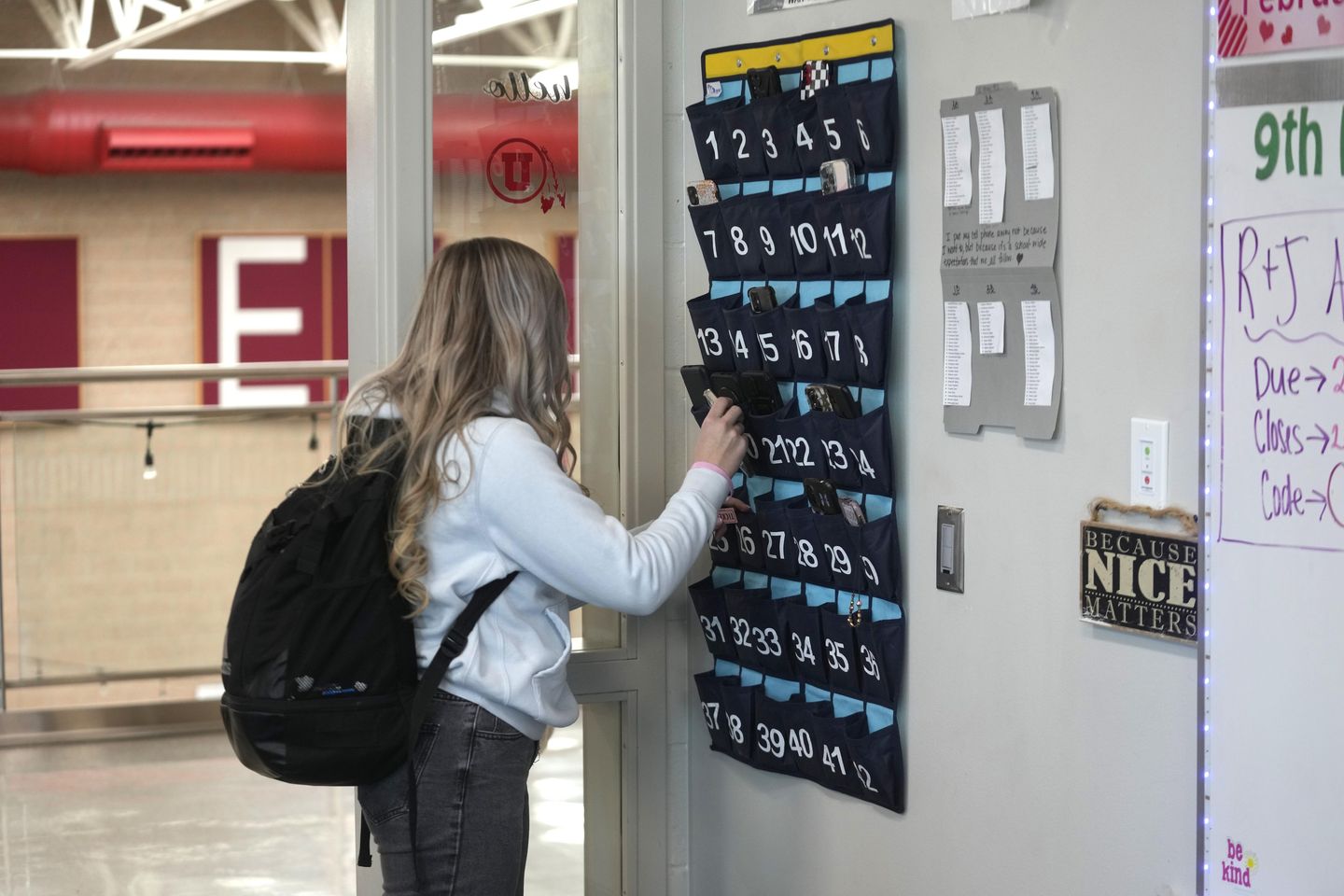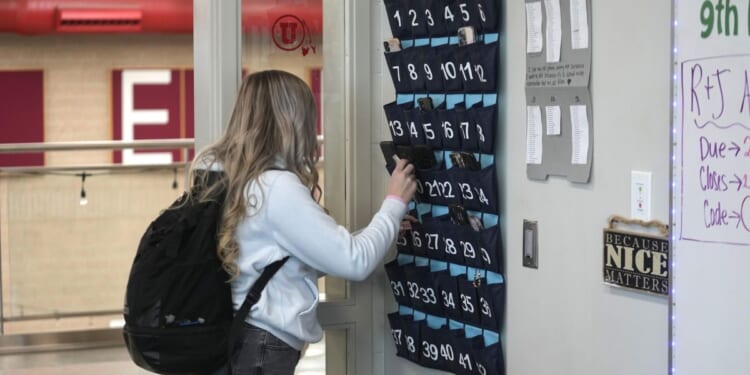
Early reports show that recent smartphone bans in public schools have improved student participation and performance, overcoming initial classroom resistance.
A working paper published this month by the National Bureau of Economic Research found that, starting in 2023, Florida students who were required to put away their phones during instructional time showed “significant positive effects” on standardized test scores.
The paper also found no increase in disciplinary incidents or in-school suspensions after two years. A spike in the first year quickly reversed in the second year.
At schools with high cellphone activity before the policy change, average test scores on Florida’s standardized exam showed the equivalent of a 10-point gain on the SAT.
The study found that the average student had one fewer unexcused absence.
“Common sense seems to be backed up by the data,” said David N. Figlio, a University of Rochester economics professor who co-authored the paper. “Our findings support the anecdotal evidence that smartphones are a huge distraction, and removing them is conducive to a calmer learning environment.”
The study, which awaits peer review, is the first to investigate the objective outcome of smartphone restrictions in dozens of states over the past two years.
It builds on multiple teacher surveys showing similar results, especially in states that have expanded bans to include the entire school day.
“As both an elementary school teacher’s aide and someone who runs a wellbeing program, I’ve seen how bell-to-bell smartphone bans can really shift the classroom atmosphere,” said Laura DeCook, the California-based founder of LDC Wellbeing, which leads mental health workshops for families.
Reached for comment, some education analysts and child safety advocates hailed the study as a game-changer for policymakers.
“This is the kind of research we’ve been looking for to help more lawmakers around the country feel confident about banning smartphones in the next legislative session,” said Jonathan Butcher, a senior fellow of education policy at the conservative Heritage Foundation.
Ray Guarendi, a Catholic media personality and family psychologist in Canton, Ohio, said the study shows why “well over half the states” have restricted student devices.
“The early possession of smartphones among teens and younger children has had a devastating effect on their maturity, morality, social connections and mental health,” said Mr. Guarendi, whose state has given school districts until Jan. 1 to ban smartphones from bell to bell.
Actual changes?
Others challenged the findings by doubting whether changes in school policies have resulted in changes in actual classroom interactions.
“States and districts are kidding themselves if they think that by passing a phone ban, phones will magically disappear from schools,” said Michael J. Petrilli, president of the right-leaning Thomas B. Fordham Institute, an education think tank in New York, which enacted a bell-to-bell ban in May. “We have very little information to date about whether these bans are actually being enforced.”
Psychologist Matthew Mulvaney, a parenting researcher at Syracuse University in upstate New York, said other research suggests that school restrictions haven’t stopped children from using phones to avoid homework and social interactions.
“The data that exists actually isn’t particularly compelling in favor of the bans,” Mr. Mulvaney said.
The Florida study analyzed one large school district.
It found that Black students and boys experienced the largest first-year surge in disciplinary problems after 2023. Effects were highest in middle and high schools, where student smartphone ownership was more widespread than in grade schools.
Many public schools have been unwilling to ban phones.
Phones in Focus, a research initiative supported by the National Governors Association, reported this month that nearly half of 20,000 public school teachers it surveyed said their schools had an ineffective “no show” policy.
That made “no show,” which allows students to keep their phones in a backpack or back pocket, the most common storage policy nationwide.
“‘Away all day’ policies that require students to keep their phones in lockers or pouches bell-to-bell perform better than less restrictive policies,” said Kris Perry, executive director of the nonprofit research network Children and Screens. “This could be, in part, because other policies are harder to enforce.”
Unplugging schools
The first statewide K-12 smartphone restrictions appeared when Florida restricted devices during instructional time in May 2023.
This May, Gov. Ron DeSantis, a Republican, signed an update that strengthened the ban. Now, K-8 students must lock their phones in pouches throughout the school day.
As of this month, an online tracker from the trade publication Education Week found that 21 states and the District of Columbia require most or all public school students to do the same.
That includes Arizona, California, Florida, Georgia, Idaho, Missouri, New York, Ohio, Oregon, Texas and Virginia.
Another eight states, including Indiana, Iowa, Nevada and Utah, have banned phones during class time only. Minnesota and West Virginia have directed schools to devise individual policies.
The remaining 19 states, including Maryland, Kansas and Colorado, have no statewide restriction.
Child safety experts say bell-to-bell bans have become the preferred policy for obvious reasons.
“Kids are less likely to skip school when they know they need to be present to have their phones returned at the end of the day,” said Scott Kollins, chief medical officer at Aura, a Boston-based app that helps parents monitor children’s digital use.
Allison J. Bonacci, director of education for Cyber Safety Consulting, an Illinois-based company that works with schools to develop internet safety policies, said teachers reported losing up to 10 minutes of class time per period to phone misbehavior before the restrictions went into effect.
That’s roughly one-fifth of a 50-minute class period.
“This issue was especially common when students were allowed to keep devices in their pockets or lockers during parts of the school day, making access too easy and temptation too high,” Ms. Bonacci said.
Bipartisan support
Support for smartphone restrictions has started to span the ideological spectrum, with left-leaning teachers unions joining conservative think tanks in recent months.
Most statewide bell-to-bell bans started this year, including those in Republican-controlled Missouri and Democratic-led New York.
Lance Izumi, an education analyst at the free market Pacific Research Institute in California, said feedback has been largely positive. His state has required all districts to ban phones by July.
“Smartphone bans make sense both in terms of student learning and improving social interaction between students,” said Mr. Izumi, a California education official under Gov. Arnold Schwarzenneger, a Republican.
The National Education Association, the nation’s largest teachers union, endorsed bell-to-bell bans on “personal devices” in June, with limited exceptions for students with special learning needs.
In a 2024 survey, the NEA found that 83% of teachers favored banning student phones all day, while 90% supported banning them at least during instructional time.
“Youth remain cautious of bell-to-bell cellphone policies but do support some level of restriction of cellphones in order to curb distraction during class,” Nico Ballon, an NEA spokesman, said in an email.
The American Federation of Teachers, the nation’s second-largest teachers union, has likewise endorsed the bell-to-bell smartphone ban that New York lawmakers enacted in May.
“Smartphones, and especially social media apps, are designed to draw kids in with addictive algorithms that profit from their attention and hurt their mental health,” AFT President Randi Weingarten said in an email.
















